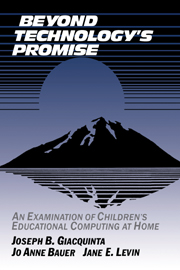Book contents
- Frontmatter
- Contents
- List of Tables and Figures
- Preface
- Chapter 1 THE PROMISE
- Chapter 2 STUDYING THE PROMISE
- Chapter 3 THE ABSENCE OF CHILDREN'S ACADEMIC COMPUTING AT HOME
- Chapter 4 THE AVAILABILITY OF EDUCATIONAL SOFTWARE
- Chapter 5 THE IMPORTANCE OF PARENTAL ENCOURAGEMENT AND ASSISTANCE
- Chapter 6 THE ROLE OF GENDER IN HOME COMPUTER USE
- Chapter 7 SCHOOL USE OF COMPUTERS
- Chapter 8 CHILDREN'S PREFERENCE FOR GAMES
- Chapter 9 REDEFINING A NEW TECHNOLOGY AS A SOCIAL INNOVATION
- Chapter 10 VIEWING TECHNOLOGICAL CHANGE AS A SOCIAL PROCESS
- Chapter 11 REEXAMINING THE HOME-SCHOOL COMPUTER CONNECTION
- Chapter 12 WHERE DO WE GO FROM HERE?
- Appendix A A FURTHER NOTE ON SITE FIELDWORK AND ANALYSIS
- Appendix B LIST OF CODES FOR SITE LOG ANALYSIS
- Appendix C SITE LOG ANALYSIS CODEBOOK
- Appendix D LIST OF FAMILIES AND SCHOOL-AGED CHILDREN
- Appendix E SPECIFIC STEPS FAMILIES MIGHT TAKE
- References
- Index
Chapter 1 - THE PROMISE
Published online by Cambridge University Press: 05 March 2012
- Frontmatter
- Contents
- List of Tables and Figures
- Preface
- Chapter 1 THE PROMISE
- Chapter 2 STUDYING THE PROMISE
- Chapter 3 THE ABSENCE OF CHILDREN'S ACADEMIC COMPUTING AT HOME
- Chapter 4 THE AVAILABILITY OF EDUCATIONAL SOFTWARE
- Chapter 5 THE IMPORTANCE OF PARENTAL ENCOURAGEMENT AND ASSISTANCE
- Chapter 6 THE ROLE OF GENDER IN HOME COMPUTER USE
- Chapter 7 SCHOOL USE OF COMPUTERS
- Chapter 8 CHILDREN'S PREFERENCE FOR GAMES
- Chapter 9 REDEFINING A NEW TECHNOLOGY AS A SOCIAL INNOVATION
- Chapter 10 VIEWING TECHNOLOGICAL CHANGE AS A SOCIAL PROCESS
- Chapter 11 REEXAMINING THE HOME-SCHOOL COMPUTER CONNECTION
- Chapter 12 WHERE DO WE GO FROM HERE?
- Appendix A A FURTHER NOTE ON SITE FIELDWORK AND ANALYSIS
- Appendix B LIST OF CODES FOR SITE LOG ANALYSIS
- Appendix C SITE LOG ANALYSIS CODEBOOK
- Appendix D LIST OF FAMILIES AND SCHOOL-AGED CHILDREN
- Appendix E SPECIFIC STEPS FAMILIES MIGHT TAKE
- References
- Index
Summary
It seems that the message the parents are buying, along with their home computers, is pretty clear: one way or another – both in school and at home – computers can help American education pull itself up by its bootstraps.
(Komoski, 1984, p. 245)Home computing became a reality in the late 1970s after Steven Jobs and Stephan Wozniak, working in a garage, created their stand-alone micro computer, the Apple.1 In their book Silicon Valley Fever, Rogers and Larsen (1984, p. 11) describe the Apple's inauspicious “birth” and the poor impression it made on computer figures like Nolan Bushnell:
Jobs and Wozniak… went to their bosses at Atari and Hewlett-Packard with it. Jobs tried to convince Nolan Bushnell, founder of Atari and creator of Pong, the first video game, that microcomputers had a bright future. But computers were not in Atari's product line, and Bushnell laughed at Jobs.
Nearly ten years later, however, Bushnell ruefully recalled: “We all knew that profits were in mainframes and minicomputers. That was in 1975.… I never said we were perfect.” By 1982, when Time named the personal computer its “Man of the Year,” sales of microcomputers had topped $5.4 billion (Rogers and Larsen, 1984, pp. 11-12).
Rogers and Larsen (1984, p. 17) also point out that the promise of the personal computer could not have been fulfilled without the “thousands of software programmers around the country” who had ideas about how the Apple could be used for education and for other purposes:
When the hobbyist market for microcomputers dried up in 1978, dozens of little computer firms collapsed.
- Type
- Chapter
- Information
- Beyond Technology's PromiseAn Examination of Children's Educational Computing at Home, pp. 1 - 12Publisher: Cambridge University PressPrint publication year: 1994

